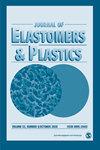Effect of Shearing on the Reinforcement Properties of Vital Wheat Gluten
IF 1.6
4区 材料科学
Q4 MATERIALS SCIENCE, MULTIDISCIPLINARY
引用次数: 3
Abstract
An aqueous dispersion of vital wheat gluten and styrenebutadiene rubber was subjected to high-shear mixing in an attempt to reduce the aggregate size and enhance filler—matrix interactions with the goal of improving contributions of the reinforcement to the overall composite properties. Composites were formulated using 10—40% vital wheat gluten by mixing aqueous suspensions of the gluten and rubber, then freeze-drying and compression molding the resulting composite. Rheological experiments indicated that vital wheat gluten reinforced the rubber up to a factor of roughly 30. Subjecting the gluten suspension to high shearing reduced the particle size from approximately 5.2—4.5 µm, and 16 min was the optimum shearing time since shearing the dispersions longer did not result in any additional size reduction. Composites with 10% vital wheat gluten have good potential in applications requiring high elasticity since they were equal to or better than the carbon black control in terms of Young’s modulus, percent elongation, and toughness. Isolated vital wheat gluten was studied in order to determine its relative merit as one of the two reinforcing components of wheat flour (the other being wheat starch), and vital wheat gluten’s reinforcing ability was a factor of 10 weaker than wheat flour, indicating that wheat starch is a much more effective biomaterial filler in terms of rigidity, but vital wheat gluten may be more suitable for applications requiring more elasticity.剪切对活性小麦面筋增强性能的影响
将重要的小麦面筋和丁苯橡胶的水相分散体进行高剪切混合,以减小骨料尺寸,增强填料与基体的相互作用,从而提高增强剂对复合材料整体性能的贡献。将10-40%的活性小麦面筋与橡胶水悬浮液混合制成复合材料,然后冷冻干燥和压缩成型。流变学实验表明,重要的小麦面筋使橡胶的强度增加了大约30倍。对面筋悬浮液进行高剪切可使颗粒尺寸从约5.2-4.5µm减小,16 min为最佳剪切时间,因为剪切时间延长不会导致颗粒尺寸进一步减小。含有10%活性麦麸的复合材料在需要高弹性的应用中具有良好的潜力,因为它们在杨氏模量,伸长率和韧性方面等于或优于炭黑控制。为了确定其作为小麦粉的两种增强成分之一(另一种是小麦淀粉)的相对优点,对分离的活性小麦面筋进行了研究,活性小麦面筋的增强能力比小麦粉弱10倍,这表明小麦淀粉在刚性方面是一种更有效的生物材料填料,但活性小麦面筋可能更适合需要更多弹性的应用。
本文章由计算机程序翻译,如有差异,请以英文原文为准。
求助全文
约1分钟内获得全文
求助全文
来源期刊

Journal of Elastomers and Plastics
工程技术-材料科学:综合
CiteScore
3.30
自引率
5.90%
发文量
41
审稿时长
6 months
期刊介绍:
The Journal of Elastomers and Plastics is a high quality peer-reviewed journal which publishes original research on the development and marketing of elastomers and plastics and the area in between where the characteristics of both extremes are apparent. The journal covers: advances in chemistry, processing, properties and applications; new information on thermoplastic elastomers, reinforced elastomers, natural rubbers, blends and alloys, and fillers and additives.
 求助内容:
求助内容: 应助结果提醒方式:
应助结果提醒方式:


